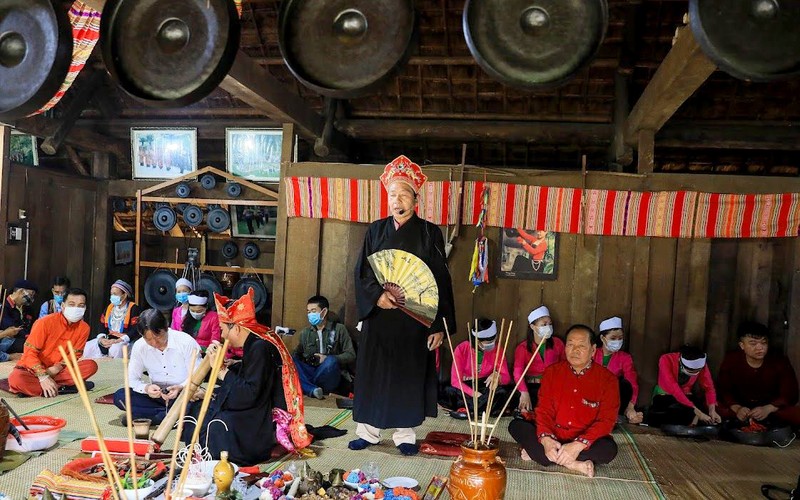
(HBO) – Mo Muong is a kind of heritage holding the special cultural essence of the Muong ethnic people. To seek the world heritage title for Mo Muong, it needs to be assessed in comparison with the Muong ethnic culture and similar heritage types in the world so as to highlight its unique values.
A Mo shaman practices a ritual in a house of
Muong people.
Mo Muong is a form of folk belief consisting of
three main factors: the environment for practices, Mo lyrics, and Mo artisans.
Recently, an international workshop on Mo Muong
and similar rituals of beliefs in the world has been held in Hoa Binh province
by the provincial Department of Culture, Sports and Tourism and the Musicology
Institute under the Vietnam National Academy of Music. It helped supplement
scientific information about Mo Muong and created a chance for the community
possessing this heritage to directly take part in the compilation of a dossier
seeking the UNESCO recognition of Mo Muong as part of world intangible cultural
heritage in need of urgent safeguarding.
Dr Do Quang Trong, Deputy Director of the Thanh
Hoa provincial Department of Culture, Sports and Tourism, and Dr Nguyen Van
Hai, Director of Thanh Hoa’s centre for history studies and cultural heritage
preservation, said Mo Muong is sacred folk rituals of the Muong ethnic minority
in funerals or ceremonies praying for good things.
It is associated with the human life cycle, they
said, elaborating that a Mo shaman prays for blessing for a newborn; expels
evil spirits from a sick person; performs rituals in weddings, ancestor worship
ceremonies, or new house celebrations; and serves as a bridge seeing off the
soul of the deceased to the afterlife.
About special values of Mo Muong, researcher and
Meritorious Artisan Bui Van Noi said the first outstanding value is its epic
characteristic with content related to the history of the Muong ethnic group
and humankind. The heritage also bears spiritual and custom values, teaches
people lessons about industriousness, along with values in terms of philosophy,
performing arts, and demonstration language.
Prof. and Dr Wolfgang Mastnak from Germany’s
University of Music and Performing Arts Munich held that Mo Muong matches many
UNESCO criteria for intangible cultural heritage such as its compatibility with
human rights and mutual respect for culture; being considered an indispensable
part of the cultural life by the community practicing it; and being deeply
rooted in the community and continuously passed down to future generations and
recreated.
Mo Muong reflects cultural diversity in the world
and also the creativity of humankind, he added.
However, amid the wave of modern cultures, Mo
Muong is facing the risk of disintegration, requiring all-round solutions to
preserve and bring it into play.
MA Vu Thanh Lich, Deputy Director of the Ninh Binh
provincial Department of Culture and Sports, and Dr Nguyen Thi Thanh Van from
the Hanoi University of Culture pointed out the need for concerted and strong
engagement from relevant parties, including local administrations, cultural
authorities, the community possessing the heritage, researchers, and relevant
organisations and individuals to uphold and promote the values of Mo Muong in
the Muong ethnic community./.
The People’s Committee of Lac Son district held a ceremony on April 28 to receive the provincial relic certificate for the ancient rock carving site at Suoi Co stream, located in My Thanh commune.
A special music show titled "The country is in the fullness of joy” has been held at Hoa Binh Square in Hoa Binh city in celebration of the 50th anniversary of the liberation of the South and national reunification (April 30, 1975–2025).
The People's Committee of Lo Son commune, Tan Lac district, has organised the local annual traditional stream fishing festival on April 19 - 20.
As a land deeply intertwined with human history and Vietnam’s millennia-long journey of nation-building and defence, Hoa Binh is often revered for its epic tales and legends.
Residents of Hoa Binh boast a rich cultural identity, reflected in their unique language, traditional attire, customs, and folk melodies – described as "sweet as honey, clear as a mountain stream.”
Lac Son district’s Vu ban town held the 2025 Truong Kha temple festival on April 12–13 (the 15th–16th days of the third lunar month). Since its revival in 2019, the festival has been organised every three years, preserving valuable intangible heritage while meeting the community’s cultural and spiritual needs.



